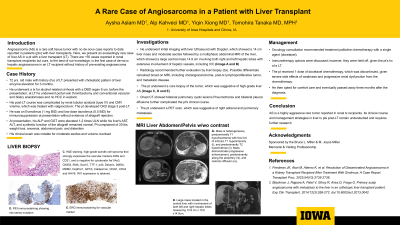Tuesday Poster Session
Category: Liver
P4755 - A Rare Case of Angiosarcoma in Patients With Liver Transplant
Tuesday, October 29, 2024
10:30 AM - 4:00 PM ET
Location: Exhibit Hall E

Has Audio
- AA
Aysha Aslam, MD
University of Iowa Hospitals & Clinics
Iowa City, IA
Presenting Author(s)
Aysha Aslam, MD1, Tomohira Tanaka, MD2
1University of Iowa Hospitals & Clinics, Iowa City, IA; 2University of Iowa Hospitals and Clinics, Iowa City, IA
Introduction: Angiosarcoma (AS) is a rare soft tissue tumor with no de-novo case reports to date reported in patients (pts) with liver transplants. Here, we present an exceedingly rare case of liver AS in a pt with a liver transplant (LT).
Case Description/Methods: 72 yrs. old male with history (hx) of LT presented with cholestatic pattern of liver enzyme elevation for 3 months. He underwent a tx for alcohol-related cirrhosis with a DBD organ 6 yrs.before the presentation; at LT heunderwent portal vein thrombectomy. There was no HCC in explant. His post-LT course was complicated by CMV viremia, which was treated with valganciclovir. The pt developed CKD stage 3 post-LT. He was on Everolimus (1 mg BID) and low-dose tacrolimus (0.5 BID) for immunosuppression at presentation without evidence of allograft rejection. At presentation, his ALP and GGT were elevated 1-2 times ULN while his liver's AST, ALT, and synthetic function of the allograft remained normal. Pt complained of 20 lbs. weight loss, anorexia, abdominal pain, and distention. He underwent initial imaging with liver Ultrasound with Doppler, which showed a 14 cm liver mass and moderate ascites followed by a multiphasic abdominal MRI of the liver, which showed a large central mass 14.9 cm involving both right and left hepatic lobes with extensive involvement of hepatic vessels, including IVC. Radiology recommended further evaluation by liver biopsy (bx). Possible differentials remained broad on MRI, including cholangiocarcinoma, post-tx lymphoproliferative tumor, and metastatic disease. The pt underwent a core biopsy of the tumor, which was suggestive of high-grade liver AS. Chest CT showedbilateral pulmonary cystic lesions. Pneumothorax and bilateral pleural effusions further complicated the pt's clinical course. The pt underwent a PET scan, which was suggestive of right adrenal and pulmonary metastasis. Oncology consultation recommended treatment palliative chemotherapy with a single agent (docetaxel). Immunotherapy options were discussed; however, they were held off, given the pt's hx of a LT. The pt received 1 dose of docetaxel chemotherapy, which was discontinued, given severe side effects of weakness and progressive renal dysfunction from the chemotherapy. He then opted for comfort care and eventually passed away three months after the diagnosis
Discussion: AS is a highly aggressive rare tumor reported in renal tx recipients. Its clinical course and management strategies in liver tx pts post-LT remain understudied and requires further research.
Disclosures:
Aysha Aslam, MD1, Tomohira Tanaka, MD2. P4755 - A Rare Case of Angiosarcoma in Patients With Liver Transplant, ACG 2024 Annual Scientific Meeting Abstracts. Philadelphia, PA: American College of Gastroenterology.
1University of Iowa Hospitals & Clinics, Iowa City, IA; 2University of Iowa Hospitals and Clinics, Iowa City, IA
Introduction: Angiosarcoma (AS) is a rare soft tissue tumor with no de-novo case reports to date reported in patients (pts) with liver transplants. Here, we present an exceedingly rare case of liver AS in a pt with a liver transplant (LT).
Case Description/Methods: 72 yrs. old male with history (hx) of LT presented with cholestatic pattern of liver enzyme elevation for 3 months. He underwent a tx for alcohol-related cirrhosis with a DBD organ 6 yrs.before the presentation; at LT heunderwent portal vein thrombectomy. There was no HCC in explant. His post-LT course was complicated by CMV viremia, which was treated with valganciclovir. The pt developed CKD stage 3 post-LT. He was on Everolimus (1 mg BID) and low-dose tacrolimus (0.5 BID) for immunosuppression at presentation without evidence of allograft rejection. At presentation, his ALP and GGT were elevated 1-2 times ULN while his liver's AST, ALT, and synthetic function of the allograft remained normal. Pt complained of 20 lbs. weight loss, anorexia, abdominal pain, and distention. He underwent initial imaging with liver Ultrasound with Doppler, which showed a 14 cm liver mass and moderate ascites followed by a multiphasic abdominal MRI of the liver, which showed a large central mass 14.9 cm involving both right and left hepatic lobes with extensive involvement of hepatic vessels, including IVC. Radiology recommended further evaluation by liver biopsy (bx). Possible differentials remained broad on MRI, including cholangiocarcinoma, post-tx lymphoproliferative tumor, and metastatic disease. The pt underwent a core biopsy of the tumor, which was suggestive of high-grade liver AS. Chest CT showedbilateral pulmonary cystic lesions. Pneumothorax and bilateral pleural effusions further complicated the pt's clinical course. The pt underwent a PET scan, which was suggestive of right adrenal and pulmonary metastasis. Oncology consultation recommended treatment palliative chemotherapy with a single agent (docetaxel). Immunotherapy options were discussed; however, they were held off, given the pt's hx of a LT. The pt received 1 dose of docetaxel chemotherapy, which was discontinued, given severe side effects of weakness and progressive renal dysfunction from the chemotherapy. He then opted for comfort care and eventually passed away three months after the diagnosis
Discussion: AS is a highly aggressive rare tumor reported in renal tx recipients. Its clinical course and management strategies in liver tx pts post-LT remain understudied and requires further research.
Disclosures:
Aysha Aslam indicated no relevant financial relationships.
Tomohira Tanaka indicated no relevant financial relationships.
Aysha Aslam, MD1, Tomohira Tanaka, MD2. P4755 - A Rare Case of Angiosarcoma in Patients With Liver Transplant, ACG 2024 Annual Scientific Meeting Abstracts. Philadelphia, PA: American College of Gastroenterology.
